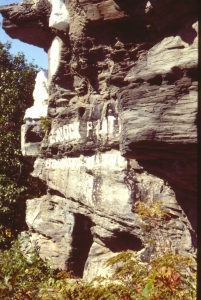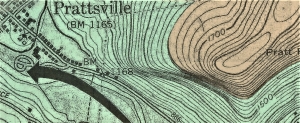Some Shiny Rocks in Plattekill Clove. 6-20-24
Some shiny rocks in Plattekill Clove
Robert and Johanna Titus
The Catskill Geologists; The Mountain Eagle; July 12, 2019
It’s not unusual for us to hear from one of our readers. That’s, after all, why we publish our email address at the bottom of each article. It is also not unusual for them to send us a photo of something worth writing about. That happened recently when someone we know as “Catskill Bear” sent us this week’s photo. Mr. Bear found this rock along the road in Plattekill Clove. He was most curious about the striated and shiny surface he saw on it. That makes up the whole left side of the rock in his photo.

Well, we recognized what this was right away, but we still needed some help on it, so we contacted our friend, Dr. Charles (“Chuck”) Ver Straeten at the New York State Museum, and asked him about it. Chuck is a geologist who knows just about everyhing there is to know about the Devonian age stratified rocks of the Catskills so we knew he would be able to help.
We already knew the fundamentals: what our reader had found was a shiny surface called a slickenside. We had been transported back to a landcape called the Catskill Delta. It was about 385 million years ago, the middle of the Devonian time period, and that delta was spread out across all of today’s Catskills. There was a tropical climate here way back then. And many geologists think that the climate was seasonal with dry months and wet months every year. Much of the delta was blanketed in a common soil type called a vertisol.
Scientists know a lot about vertisols because they exist today. They possess clay minerals that shrink during the dry seasons and expand when they get wet. That creates a back-and-forth motion within the soil. One mass of soil expands and slides past the other during the wet season. It contracts and slides past the other mass in the following dry season. The result of all this are soil slickensides. And that is exactly what Catskill Bear had found.
But there is more; it seems like there is always more. Chuck has, himself, been interested in Devonian soil slickensides. He has noticed that they are concentrated in certain horizons within Catskills stratigraphy. There are stretches of Catskills stratified rock where they are common and other stretches where they are not. He wondered why.
It’s common for Nature to present scientists with patterns like this. Nature is challenging us: where there is a pattern, then we must seek to learn why. If we meet the challenge and answer that question, then we are likely to have discovered something. It’s a common way that science works, and a fun way.
Chuck developed a hypothesis to explain this. A scientific hypothesis is a tentative explanation. It has not been properly tested and thus has not been proved – not yet. Chuck has long understood that volcanic eruptions can produce the clay minerals that promote expansion and contraction in vertisol soils. His hypothesis is that explosive Devonian eruptions in New England might have showered our region with ash that, potentially, could have been be altered into those “shrinking clays” and thus subjecting local soils to seasonal expansion and contraction. Slickensides would be concentrated in certain stratigraphic sequences because those represent times of volcanic activity. Sounds good, doesn’t it? But this is just hypothesis; it still needs work.
In the end, slickensides are among many, many phenomena that we routinely encounter in the Devonian strata of the Catskills. You too can learn about them. With time, you learn to notice these things. They speak to you about the past. You have become more knowledgeable. Your hikes in the Catskills become such different, more enriched, experiences. And it all starts from reading these columns.
Have you found some interesting geology? Write us about it. We are at randjtitus@prodigy.net. Join our facebook page “The Catskill Geologist.” Read our blogs at “thecatskillgeologist.com









